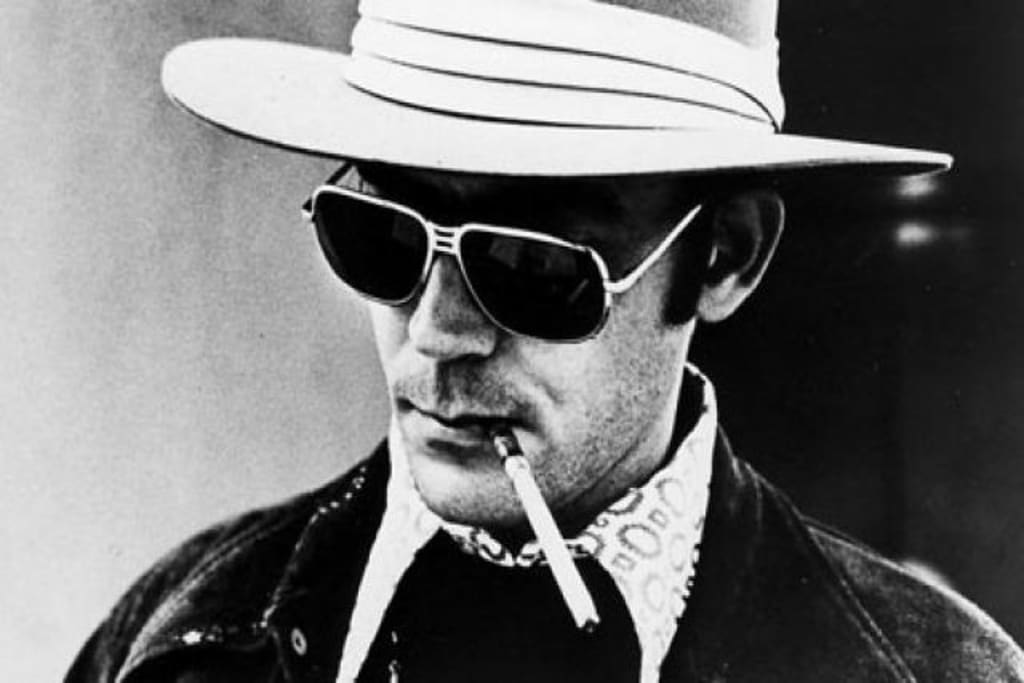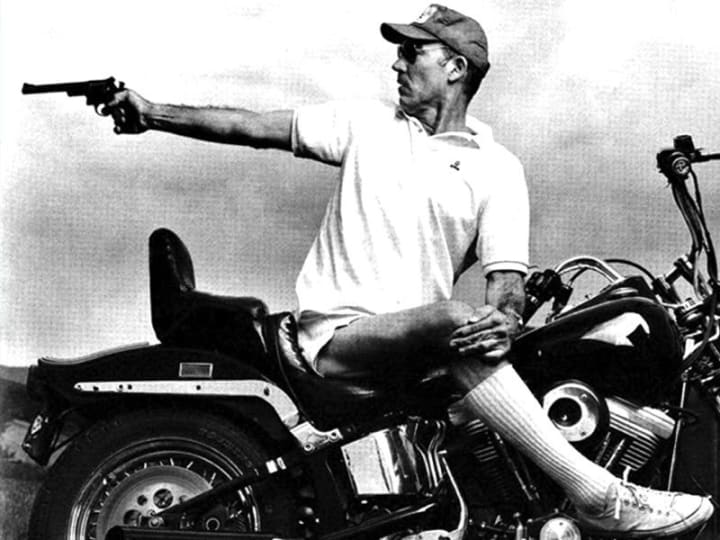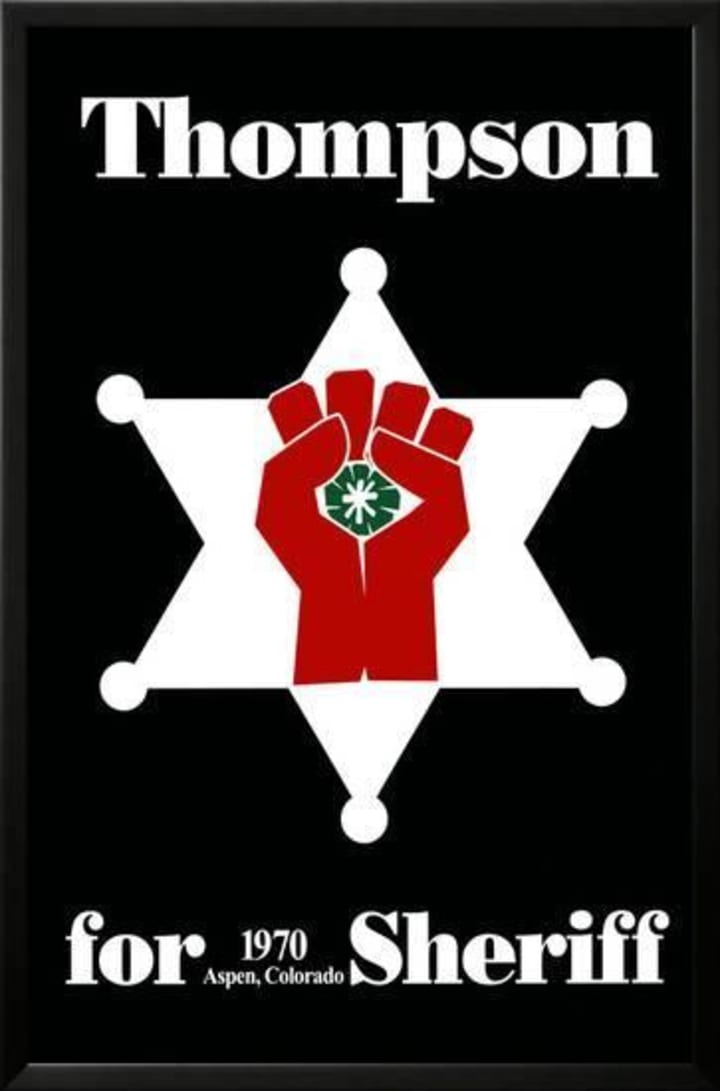The American Jekyll & Hyde
A Reflection of Hunter S. Thompson

A genius to some and a madman to others. Through his writing, he wished to strengthen the 1960’s counter culture and expose the truth about America, by means of drugs, alcohol, violence, and firearms. He is idolized by a generation and feared by those who were closest to him. In the end, he realized that at the age of 67, he could no longer control or live up to the entity for which he cad created; resulting in a final bang from a Smith & Wesson pistol.
Born on July 18, 1937 in Louisville, Kentucky, Hunter Thompson was the son of Jack Thompson and Virginia Davidson. Those who befriended him, say that he had the “All American Childhood”. By the time he was a teenager, Hunter had shown signs of great literary talent. He wrote for his high school newspaper, and was later accepted into the Atheneum Literary Association. Yet it was also at this time, when Hunter’s path in life would would be charted into a new course, which he had no control over.
In 1952, Hunter’s father passed away after being diagnosed with a long-term, neuromuscular, disease, known as myasthenia gravis. Following his father’s death, his mother would become addicted to alcohol, and Hunter would abandon everything that made him who he once was. Like the first time that Dr. Jekyll experimented with his mysterious potion, Hunter S. Thompson began to transform into the non-conformist rebel which would later define his life. He began to commit acts of vandalism, sexual harassment to women, public intoxication, and participation in robberies. Eventually he was arrested, imprisoned for two months, and unable to finish school.

By 1964, Hunter S. Thompson had left his home in Kentucky for greener pastures and hopes to start life anew. With his first wife, Sandra, and his son, Juan, the Thompson family resided in San Francisco, California. With nothing else to fall back on after forcibly dropping out of school, Hunter vowed to write for a living. As a means of developing his skills in literature (as well as figuring out how it “felt” to write great work), Hunter would spend countless hours at his typewriter, copying the works of F. Scott Fitzgerald, William Falkner, and Ernest Hemingway. His first major opportunity arrived, when he was given the offer to write a series of articles about the inside activities of a up and coming motorcycle club, known as the Hell’s Angels. These articles would range from short poems about bar fights and large herd-like journeys along Route 66, to detailed accounts about drug dealings and organized murders. After two years of riding, Thompson took these articles and fused them together into his first novel. Hells Angels: A Strange and Terrible Saga of the Outlaw Motorcycle Gangs.

"California, Labor Day weekend... early, with ocean fog still in the streets, outlaw motorcyclists wearing chains, shades and greasy Levi’s roll out from damp garages, all- night diners and cast-off one-night pads in Frisco, Hollywood, Berdoo and East Oakland, heading for the Monterey peninsula, north of Big Sur... The Menace is loose again, the Hell’s Angels, the hundred-carat headline, running fast and loud on the early morning freeway, low in the saddle, nobody smiles, jamming crazy through traffic and ninety miles an hour down the center stripe, missing by inches... like Genghis Khan on an iron horse, a monster steed with a fiery anus, flat out through the eye of a beer can and up your daughter’s leg with no quarter asked and none given; show the squares some class, give em a whiff of those kicks they’ll never know... Ah, these righteous dudes, they love to screw it on... Little Jesus, the Gimp, Chocolate George, Buzzard, Zorro, Hambone, Clean Cut, Tiny, Terry the Tramp, Frenchy, Mouldy Marvin, Mother Miles, Dirty Ed, Chuck the Duck, Fat Freddy, Filthy Phil, Charger Charley the Child Molester, Crazy Cross, Puff, Magoo, Animal and at least a hundred more... tense for the action, long hair in the wind, beards and bandanas flapping, earrings, armpits, chain whips, swastikas and stripped-down Harleys flashing chrome as traffic on 101 moves over, nervous, to let the formation pass like a burst of dirty thunder. ... The run was on. Outlaws from all over the state rolled in packs toward Monterey: north from San Bernardino and Los Angeles on 101; south from Sacramento on 50... south from Oakland, Hayward and Richmond on 17; and from Frisco on the Coast Highway. The hardcore, the outlaw elite, were the Hell’s Angels... wearing the winged death’s-head on the back of their sleeveless jackets and packing their “mamas” behind them on big “chopped hogs”. They rode with a fine, unwashed arrogance, secure in their reputation as the rottenest motorcycle gang in the whole history of Christendom." (Thompson 3-4)


Upon the novel’s publishing and initial success, the motorcycle gang demanded that Hunter give them a share of the profits. Hunter refused, which almost costed him his life. After a group of Hell’s Angels pounded him to a bloody pulp, Hunter decided to move his family to Aspen, Colorado for the sake of their safety and security. Once residing on a ranch that Hunter renamed “The Owl Farm”, he was given the offer to run for the office of county sheriff. When Thompson entered the political race in 1970, he would begin his life-long experiments with hallucinogenic drugs (cocaine, marajuana, acid, LSD, etc). Such usage and approval of narcotics would show in his campaign efforts; including the creation of his own polical party (the Freak Power Party), the advocation of marajuana plants grown on public property, and the capital punishment to dealers who sold “bad drugs”. Yet, despite having attracted a large liberal following, Hunter lost the election. It would be his first and only endeavor into the world of electable politics.


For the next two years, Hunter would continue to experiment with drugs, all the while writing an article for Scanlan’s Monthly. The article was supposed to be a piece surrounding the Kentucky Derby. Instead, Hunter submitted a piece which uses the race as the background, while focusing on how the event is nonsensically celebrated by an obsolete generation of tourists, gamblers, and southern belles. Such a piece was entitled The Kentucky Derby is Decadent and Depraved.

By mid afternoon we had everything under control. We had seats looking down on the finish line, color TV and a free bar in the press room, and a selection of passes that would take us anywhere from the clubhouse roof to the jockey room. The only thing we lacked was unlimited access to the clubhouse inner sanctum in sections "F&G"...and I felt we needed that, to see the whiskey gentry in action. The governor, a swinish neo-Nazi hack named Louis Nunn, would be in "G," along with Barry Goldwater and Colonel Sanders. I felt we’d be legal in a box in "G" where we could rest and sip juleps, soak up a bit of atmosphere and the Derby's special vibrations. ... The bars and dining rooms are also in "F&G," and the clubhouse bars on Derby Day are a very special kind of scene. Along with the politicians, society belles and local captains of commerce, every half-mad dingbat who ever had any pretensions to anything at all within five hundred miles of Louisville will show up there to get strutting drunk and slap a lot of backs and generally make himself obvious. (Thompson 6)
Ironically, what fascinated the editors at Scanlan’s Monthly, was Hunter’s personal style of writing. Unlike other journalists who write from an outsiders perspective, Hunter S. Thompson wrote without any claims of objectivity. I his mind, the journalist was to be an element of the story itself, creating a much larger sense of the scope. Whether or not his style was accidental or not, it would end up redefining 20th century writing and journalism. Soon after his article was published, Sports Illustrated offered him the job of covering the Mint 400 in Las Vegas, Nevada. With his attorney, Oscar Acosta, they traveled along the Nevada desert and gambled in the casinos along the Las Vegas strip, all while binge drinking and abusing narcotics; embracing drunken experiences and hallucinations, head on; for which Hunter wrote down with extreme vividness. By 1972,(like his previous novel), Hunter fused his Sports Illustrated article and his journal entries describing his hallucinations into what is considered his magnum opus. Fear and Loathing in Las Vegas: A Savage Journey to the Heart of the American Dream.

"We were somewhere around Barstow on the edge of the desert when the drugs began to take hold. I remember saying something like “I feel a bit lightheaded; maybe you should drive...” And suddenly there was a terrible roar all around us and the sky was full of what looked like huge bats, all swooping and screeching and diving around the car, which was going about a hundred miles an hour with the top down to Las Vegas. And a voice was screaming: “Holy Jesus! What are these goddamn animals?” Then it was quiet again. My attorney had taken his shirt off and was pouring beer on his chest, to facilitate the tanning process. “What the hell are you yelling about?” he muttered, staring up at the sun with his eyes closed and covered with wrap- around Spanish sunglasses. “Never mind,” I said. “It’s your turn to drive.” I hit the brakes and aimed the Great Red Shark toward the shoulder of the highway. No point mentioning those bats, I thought. The poor bastard will see them soon enough. ... It was almost noon, and we still had more than a hundred miles to go. They would be tough miles. Very soon, I knew, we would both be completely twisted. But there was no going back, and no time to rest. We would have to ride it out. Press-registration for the fabulous Mint 400 was already underway, and we had to get there by four to claim our sound-proof suite. A fashionable sporting-magazine in New York had taken care of the reservations, along with this huge red Chevy convertible we’d just rented off a lot on the Sunset Strip... and I was, after all, a professional journalist; so I had an obligation to cover the story, for good or ill. ... The sporting editors had also given me $300 in cash, most of which was already spent on extremely dangerous drugs. The trunk of the car looked like a mobile police narcotics lab. We had two bags of grass, seventy-five pellets of mescaline, five sheets of high-powered blotter acid, a salt shaker half full of cocaine, and a whole galaxy of multi-colored uppers, downers, screamers, laughers and also a quart of tequila, a quart of rum, a case of Budweiser, a pint of raw ether and two dozen amyls. All this had been rounded up the night before, in a frenzy of high- speed driving all over Los Angeles County – from Topanga to Watts, we picked up everything we could get our hands on. Not that we needed all that for the trip, but once you get locked into a serious drug-collection, the tendency is to push it as far as you can." (Thompson 3-4)

By the time Hunter Thompson was 34, he had created a masterpiece of which nobody else had done before. Hunter himself enjoyed the newfound fame, but behind the scenes, the persona of which Hunter had created as a tool to fuel his writing, began to take on a life of it’s own. Like Edward Hyde to Dr. Henry Jekyll, this “wild man” persona began to conquer Hunter’s mind and he soon realized that in order to maintain his fame and continue writing great work, he had to continue his binge drinking and drug abuse; which in turn, was destroying his health and (later) his family, after Sandra filed for divorce. For the next 33 years, Hunter would write articles for Rolling Stone Magazine, publish 6 more novels (Fear and Loathing On the Campaign Trail 72’, The Great Shark Hunt, Better Than Sex, Fear and Loathing In America, and The Rum Diary), and witness two of his books transform into movies starring Johnny Depp.

However, the writings that he was doing at this time, were never at the same standards of success and critical acclaim as his previous works. As American society and culture progressed into the 21st century, Hunter was unable to change with the times. Therefore, the world around him was interpreting him as less of a political figure with something to say, and more of the drunk, drug-addicted, character that he had created. By 2005, Hunter had come to terms with his potential fate. At the age of 67, he had undergone numerous surgeries on his knees, back, and hips; and with his continuous drinking, smoking, cocaine snorting, and countless hours in his makeshift shooting gallery with his collection of firearms, he was at a crossroads. He could either continue this way of life forever and rot away like a pencil’s eraser, or move on so that his legacy would remain forever in the minds of others. On the evening of February 20, a gunshot was reported at Hunter’s Colorado ranch. When the police arrived, Hunter S. Thompson was found in his office room, with his head collapsed against his typewriter. He had shot himself with his favored Smith & Wesson 45. Automatic Pistol. Later, his son, Juan, discovered that on his father’s typewriter, Hunter had written out one final word. A cryptic message, which remains a mystery to fans and fellow writers alike. Counselor.

Works Cited
- Thompson, Hunter, S. Hells Angels: A Strange and Terrible Saga of the Outlaw Motorcycle Gangs. Ballantine Books. 1966. Print. March 21, 2020.
- Thompson, Hunter, S. “The Kentucky Derby is Decadent and Depraved." Scanlan’s Monthly,4 June. 1970, pg 6. Print. March 21, 2020.
- Thompson, Hunter, S. Fear and Loathing in Las Vegas, and Other American Stories. Random House, Inc. 1996. Print. March 21, 2020.
- Stevenson, Louis, Robert. The Strange Case of Dr. Jekyll and Mr. Hyde. Broadview Press. 2015. Print. March 21, 2020.
- “Nightmare: Birth of Horror - Jekyll and Hyde (BBC 1996)”. Youtube. uploaded by batrachious, 12 September 2012, www.youtube.com/watch?v=b04aSxzD4Xo. Web. March 21, 2020.
- “Hunter S. Thompson - Buy the Ticket, Take the Ride (Documentary)” Youtube. uploaded by Dr. Manhattan, 4 June 2015, https://www.youtube.com/watch?v=VlAZV_EsSSE&t=1493s. Web. March 21, 2020.
- “Hunter S. Thompson on Outlaws” Youtube. uploaded by Blank on Blank, 28 July 2015, https://www.youtube.com/watch?v=P3QoKqEHS8s. Web. March 21, 2020.
- “The Final 24 - Hunter S. Thompson.” Youtube. uploaded by The Final 24, 8 December 2015, www.youtube.com/watch?v=wpoPKll4MSA. Web. March 21, 2020.
About the Creator
Jacob Herr
Born & raised in the American heartland, Jacob Herr graduated from Butler University with a dual degree in theatre & history. He is a rough, tumble, and humble artist, known to write about a little bit of everything.






Comments
There are no comments for this story
Be the first to respond and start the conversation.